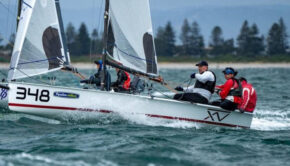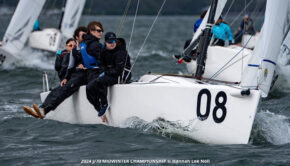Tips for Gybing Asymmetrical Spinnaker
Published on April 25th, 2016
Tim Healy (North Sails) and Andy Burdick (Melges Performance Boats) offer tips on the two types of gybes for the asymmetrical spinnaker…
Conventional Gybe
This gybe is performed in the lighter wind conditions (5-10 knots). Another indicator is the angle you are sailing downwind. If you are sailing a low angle (almost running dead downwind), then this style of gybe is best. When performing this style of gybe, you do want your jib furled during the maneuver.
The end goal with this gybe is to reduce steering through the maneuver. This allows the boat to keep consistent speed through the gybe and allows you to stay in a narrow wind lane, if needed. A clear indicator of doing this gybe correctly is if the spinnaker rotates around the headstay before the main crosses the boat.
To do this, steer down slowly while the crew overhauls the new spinnaker sheet as the boat approaches dead downwind. During this time, the crew rolls the boat, the new sheet continues to be trimmed until the spinnaker fills and the main is pulled across the boat. Once the sails are filled on the new side, the crew should use their weight to flatten the boat. As the boat is flattened, the main should be trimmed to the higher exit heading and the spinnaker should be eased because the spinnaker is over trimmed during the gybe.
Blow-Through (or Skiff) Gybe
We like to use this style of gybe in 12+ knots of wind. During the Blow-Through Gybe, the jib stays out and plays a factor in the maneuver. The end goal with this type of gybe is to achieve maximum speed going into the maneuver and then regain your speed as quickly as possible after the maneuver (spinnaker filled, proper angle of heel).
Again, we do not over-steer the boat. You have to be slow and smooth, especially now that the boat is reaching high speeds. We count down the gybe: “Gybing in 3, 2, 1”. On the 2 count the helmsperson slowly turns down. On 3 the spinnaker trimmer will begin to trim in about five feet of sheet. The forward crew will trim the jib hard creating a wall at the fore triangle of the boat. When the trimmer trims in, the clew gets pulled down which is what you want. The forward crew then grabs the clew of the spinnaker and holds it for about 1.5 seconds, all the while the boat is being steered through the gybe slowly.
The trimmer then calls “CUT”, meaning release the clew. The spinnaker then backwinds into the jib and the fore triangle of the boat. The spinnaker trimmer pulls the new sheet and, with some timing practice, the boat will exit the gybe at an angle where only 2-3 pulls on the new sheet will fill the spinnaker after the gybe.
Key indicators after the gybe: If you come out of the gybe over-heeled, then you oversteered through the process. If you come out of the gybe too low -the spinnaker will need to be overtrimmed to fill. The boat will be slow and flat in the water. Practice these!
Note: This advice was written for the Melges 24 but Tim notes that many of these points also apply to other asymmetrical spinnaker boats including the Melges 20, Melges 32, J70, and Viper 640.









 We’ll keep your information safe.
We’ll keep your information safe.